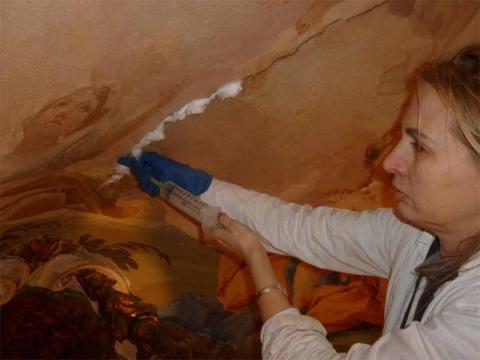Interview excerpt
In this interview, Elise Grenier, a distinguished conservator and the founder of Grenier Conservation LLC, delves into her 35-year journey in art conservation, a path that has taken her through significant projects in both the United States and Italy. Her expertise has been a vital contribution to preserving the artistic and cultural heritage found in the revered monuments of Florence, including churches, palaces, and museums, and extending throughout the picturesque landscapes of Tuscany. Since 2000, Elise has been instrumental in numerous restoration initiatives across Louisiana, encompassing a wide array of culturally and artistically significant museums, churches, and state and private monuments. Elise's dedication to the research, preservation, and promotion of art ensures that these treasures will continue to inspire and be appreciated for generations to come.
In the following conversation, Elise shares her insights on the allure and challenges of art conservation, her unique experiences in artwork restoration, and her advice for aspiring conservators in this dynamic field.

LNB Building, now The Watermark Hotel, Baton Rouge, Louisiana, restoration of Angela Gregory’s polychrome bas reliefs representing the history of Louisiana, 1954. Credit: Elise Grenier
AM: What was the defining moment that sparked your interest in art conservation, and how did that experience shape your career path?
EG: I was encouraged to draw, paint, and sculpt from an early age, but I first saw a restorer at work when traveling with my family in Europe; a man with magnifying lenses was working on a scaffold in a museum. At the time I was very young, and I didn’t fully comprehend what he was doing, but I realized that somehow he was helping the ancient artwork to survive, artwork much older than that of my native United States. Visiting other countries around the world made me realize the importance of preserving every culture’s artwork for future generations to enjoy.
Many years later I learned as a student that preservation has many varied and interesting facets - from the simple evaluation of conditions and repairing an endangered artwork, to revealing an artwork when it has been covered up with overpaint and presumed to have been lost forever.

Borgo San Sepolcro, Italy, Palazzo degli Alberti, Allegorical fresco by Cherubini Alberti, ca 1570. Credit: Elise Grenier
AM: How did your training in Florence influence your approach to art conservation, and what specific lessons from there do you still apply in your work today?
EG: I am very proud to be trained in Florence. My teachers were the conservators who saved Florence’s artwork after the Great Flood of 1966, when 50% of the city’s precious monuments and artwork were endangered by the floodwaters. Saving the endangered artwork was urgent, as well as a plan to preserve artwork in the future. Conservators agreed that the time had come to establish best practices and to employ a scientific approach in the profession. Florentine professionals became the first to enforce that all materials used by conservators must be chemically compatible with that of the original artifact.
Today the department of Chemistry for Conservation at the University of Florence is still an important resource for me. I trust them to perform my chemical analysis, and they do important research on new methodologies.
AM: You’ve mentioned preferring to leave a testimony to an artwork's age. Can you expand on how this philosophy guides your decision-making process in restoration projects?
EG: Conservation is a fairly new science. In the past, an artist was simply called in to improve on or beautify the artifact, without much regard for maintaining its original characteristics. Today we prefer to see an imperfect artwork or artifact; we don’t expect it to look the way it was when it was first created, and we are not attempting to conceal its’ age. The important thing is to keep it healthy, without adding anything of our own.

Tribunale della Mercanzia, Florence, Italy, 1350’s. Credit: Elise Grenier
AM: What advice would you give to someone interested in pursuing a career in art conservation, especially in preserving Renaissance art?
EG: In order to pursue a career in preservation or conservation, a solid background in art history, fine art techniques and materials, and applied science is preferred. It is helpful to know the process by which traditional artwork was created such as an egg tempera on panel, or a fresco, or how to carve stone, or make decorative stucco, and this is an important part of our training. We need hands-on practitioners, we need conservation scientists, and we also need those that do research.
Numerous graduate programs exist to study conservation, and you might work in private practice, or as a museum employee, or run a laboratory.
Elise Grenier has more insights to share! Read the full interview in the article ‘Unlocking the Past - Insights into the Fascinating World of Art Conservation,’ available in the January - February 2024 issue of Ancient Origins Magazine. Get it here!
Discover more about Grenier Conservation: http://www.grenierconservation.com Fb: GrenierconservationLLC
Featured Image: Gondi Palace, Florence, Italy, Wedding Alcove by painter Matteo Bonechi and stucco by Giovan Battista Ciceri, “Allegory of a Happy Marriage”, ca. 1710. Credit: Elise Grenier
By Alicia McDermott




